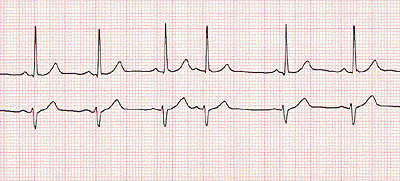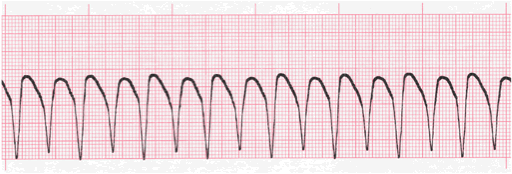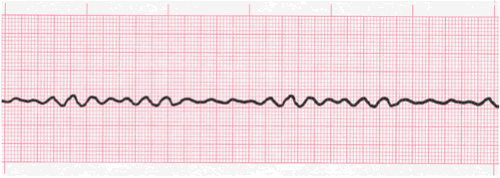
The Breakdown
aka how to do this
What is physically happening during an EKG?
P wave = atrial contraction
QRS = ventricular contraction
T wave = atria and ventricle rests
Another way to think about it→
P wave = atrial depolarization
QRS = ventricular depolarization
T wave = atria and ventricle repolarization
So sinus rhythm = the rhythm we ought to be in, where you have the following:
-1 P wave for every 1 QRS
-regular (meaning consistent) rhythm
-rate between 60 and 100
p waves = present
qrs = regular and present
rate = 60 - 100
(>100 = tachyardia, <100 = bradycardia)
treatment = none needed

Atrial Fibrillation
Most important thing: THERE IS NO P WAVE.
There are normal QRSs. The rate may be slow, fast, or normal.
The atria is FIBRILLATING, meaning jiggling. Jiggles do not a p wave make. The jiggles mean that a full contraction of the atria does not happen, which is why this person is at risk for clots to form in the heart. Any time blood slows, clots form.
(If this atria were a lazy river that I was tubing on and I had a piña colada umbrella drink, I would not spill ONE drop. Hence the clots.)
p waves = none
qrs = present
rate = irregular, varying speeds
treatment = depends on rate, may need anticoagulation (ie, heparin, warfarin, plavix)

Atrial Flutter
Now you have ALL the p waves.
Instead of fibrillating, the atria is fluttering, which means it is rapidly opening and closing. This movement makes p waves. A lot of p waves. And they're not very effective atrial contractions at all, but they do make p waves.
The qrs will most likely be going at a normal rate and will not pair with every p wave (because the ventricle is like, "um, atria, how about no.")
p waves = multiple per qrs
qrs = present
rate = irregular or regular, varying speeds
treatment = depends on rate, may need anticoagulation (ie, heparin, warfarin, plavix)

Premature Atrial Contractions
PACs are little mistakes the atria makes where it contracts too soon.
If the atria and ventricle are performing a dance routine (aka normal sinus rhythm) where sometimes the atria comes in too soon and not in time with the music, this is known as a PAC.
Note that PAC is not a rhythm. You would call this "sinus rhythm with PACs."
PACs are usually unconcerning.

Premature Ventricular Contractions
(PVCs or VPCs)
Sometimes the ventricle messes up and comes into the dance too soon as well. This is usually no big deal, as the heart will just reset and continue its sinus rhythm. Anything less than 5-6 PVCs per minute is fine.
Once you have more, however, you start to make multiple entries to a very bad lottery. Think of the concept of The Hunger Games, where more entries into the games will get you more food... but will increase your chance of being picked for a very bad prize (fighting to the death).
Once you have more PVCs, you have a higher chance of having a PVC land on a t wave that happens at the exact same moment. This is known as q-on-t phenomenon and it is very bad.
Q-on-t phenomenon will cause the heart to enter ventricular tachycardia.

Supraventricular Tachycardia
SVT
SVT is a funky rhythm that can occur when one group of cells located above the ventricle decides to hijack the rhythm. It takes over, terrorist-style, and blocks out normal sinus rhythm.
p waves = present, but sometimes hard to see
qrs = present
rate = > 200
treatment if asymptomatic:
vagal maneuver + adenosine + procedural sedation + cardioversion with sync button
treatment if symptomatic:
immediate cardioversion with sync button

Ventricular Tachycardia
Vtach
Take a look at a PVC. Imagine a whole bunch in a row. This is not good. This is known as "vtach" or ventricular tachycardia.
During vtach, the ventricle flaps open and closed rapidly. As you might suspect, this does not pump blood well.
Imagine that you are pumping a bicycle tire full of air. You do not want to quickly slam the handle up and down (ventricular tachycardia) because that won't put air into the tire very well. You also don't want to just jiggle the handle a little bit without giving a full pump (ventricular fibrillation, which we'll talk about next). A strong, steady pump is what will push the most air into the tire (sinus rhythm!) and that is not what we have here at all.
Don't see p waves? That's because there aren't any here. God knows what the atria is doing, but it doesn't even matter because this patient is CRASHING.
p waves = none
qrs = yes, wide and ugly
rate = sure, but it doesn't matter
treatment = defibrillation + epinephrine + amiodarone

Ventricular Fibrillation
Vfib
Ventricular fibrillation, or "vib", involves the quivering of the ventricle and nothing else. No pump by the ventricles or atria. No blood flowing anywhere. Nada.
p waves = none
qrs = none
rate = none
treatment = defibrillation + epinephrine + amiodarone

Asystole
This rhythm means you have virtually no electrical activity present, or at least nothing organized. No p waves, no qrs, nothing.
p waves = none
qrs = none
rate = none
treatment = DO NOT SHOCK/DEFIBRILLATE. You must do CPR.

Pulseless Electrical Activity (PEA)
PEA sometimes shows up when a patient is mostly in asystole. You get a qrs here, a p wave there, but there is no pulse and no contraction of the heart.
FYI: Do not panic. You are not expected to know that the patient above has no real pulse. THEY WILL TELL YOU THAT THE PATIENT HAS NO PALPABLE PULSE.
p waves = none
qrs = none
rate = none
treatment = Give epinephrine. Then, DO NOT SHOCK/DEFIBRILLATE. You must do CPR.

